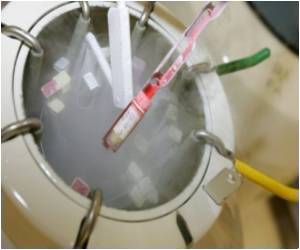It is a sad fact that people who have learned that they have cancer also are told that the therapies that may save their lives could hurt their ability ever to have children.

The good news, according to an article in the January issue of Mayo Clinic Proceedings (http://www.mayoclinicproceedings.com ), is that techniques to harvest and store reproductive cells have vastly improved in the last several years. "Fertility preservation is still an emerging discipline," says Mayo Clinic reproductive endocrinologist (http://www.mayoclinic.org/reproductive-medicine/) Jani Jensen, M.D. (http://www.mayoclinic.org/bio/13767992.html) , lead author of the paper, "but rapid advances in technology in the last several years are now providing new options for patients."
In the review, a team of Mayo researchers look at both long-standing and emerging fertility preservation technologies. Freezing sperm remains a stable and reliable technique, but one approach that has had considerable success in the last five years involves freezing eggs harvested from women. "Cryopreservation of eggs used to be considered the Holy Grail of therapy, not just for cancer patients, but for any woman who wanted to halt the biological clock," says Dr. Jensen. Oocytes are particularly fragile cells that rupture easily, and even though research to preserve them dates back to the 1970s, the first successful birth from a stored egg didn't occur until the mid-1980s. "But in the last five years," Dr. Jensen says, "there have been considerable improvements in freezing technology. Since 2004, there have been thousands of babies born worldwide from frozen eggs."
One long-standing and familiar approach available to cancer patients remains the freezing of embryos. "Embryos are hardy, and can survive the freezing and thawing process better thanindividual eggs, so they actually have a better chance of creating a successful pregnancy," Dr. Jensen explains. The approach may be a good fit for patients who are married or have a long-term partner, she adds, but it's not necessarily an answer for the youngest cancer patients.
One scientific challenge that research is now addressing is cultivating and storing sperm and egg tissue from prepubescent cancer patients. "There's promising work emerging that's striving to prompt the maturation of this tissue in the laboratory," she says. "The hope is that the tissue could be used later in patients' lives to create pregnancies. To date, there haven't been pregnancies that have resulted from this approach, but the work is under way."
Despite advances in fertility preservation treatments, a hurdle that remains is informing patients about the options that are available just as they are learning about the cancer treatment that lies ahead of them. Timing is of the essence, notes Dr. Jensen. "Fertility preservation treatments can take two to three weeks, and it's better to take the steps [to harvest and freeze cells] before cancer care begins," she says.
Advertisement
Advertisement














